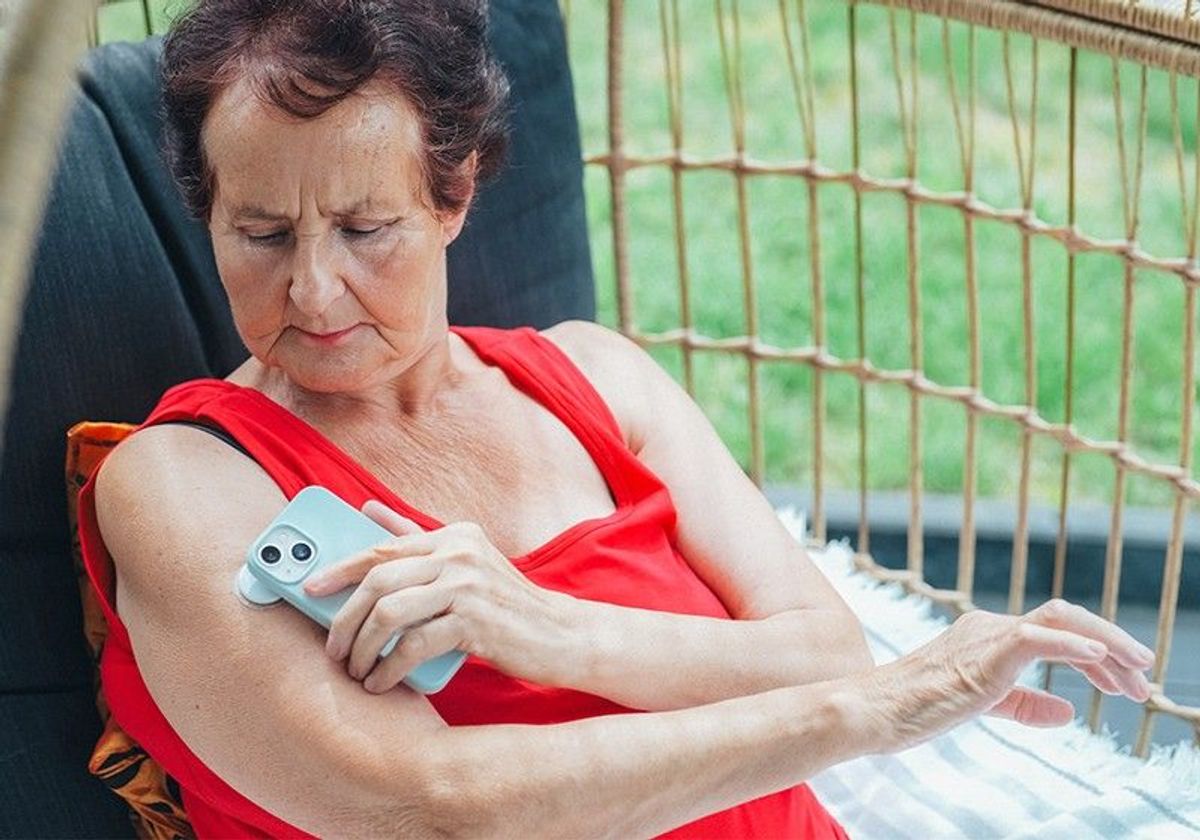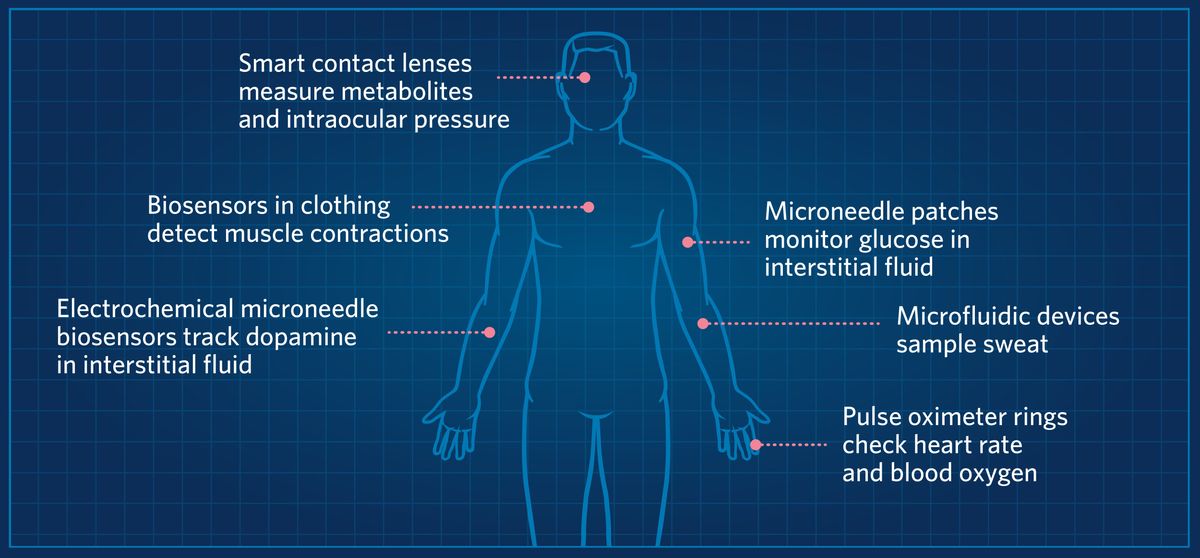
Stay up to date on the latest science with Brush Up Summaries.
What Are Wearable Biosensors?
Wearable biosensors are devices that can be worn on, inside, or near the human body to monitor biological signals.1 They provide continuous measurements of dynamic physiological parameters in real time,2 providing a digital output that can easily be interpreted and acted upon.
Wearable biosensors typically consist of a recognition region that detects the target signal, a transducer that converts that signal into a measurable parameter, and an electronic processor that enables a visual interface for the output of results.
How Do Wearable Biosensors Work?
Wearable biosensors work by detecting and measuring biological signals.3 The type of signal and how it is measured varies widely between different types of wearable biosensors. The bio-recognition region of the device, which is placed in contact with the body or bodily fluids, may contain biological molecules such as nucleic acids, enzymes, or antibodies.3 These molecules interact with relevant analytes in the bodily fluids or on the skin. They may also detect other signals, such as changes in light or heat, or the electrical activity of muscles when they contract.
When a signal is detected by the bio-recognition element, it is converted into a measurable signal by the transducer element of the device.4 The electronic circuitry of the biosensor transmits the signal to a visual display on the device itself or, in many cases, to a smartphone. This allows wearable biosensor users to monitor these signals continuously over time.

Types of Wearable Biosensors and Their Applications
Wearable biosensors became commercially available and widely popular when integrated with smartphone and smartwatch technology for the non-invasive monitoring of physical activity and related measures, such as heart rate and estimated calorie consumption.5
Another well-known type of wearable biosensor is the blood glucose monitoring device worn as a patch by people with diabetes. The biosensor patch, often worn on the upper arm, continually measures blood glucose in the fatty layer under the skin using the enzyme glucose oxidase as a recognition molecule.2 It converts and transmits the output signal to a smartphone or other receiving device.
This type of continual monitoring is important because it allows patients to improve their management of blood glucose levels, for example in conjunction with a pump that secretes insulin.6 Wearable biosensors that infer blood glucose levels from the levels found in other bodily fluids, such as sweat, tears, and saliva, have also been proposed as less invasive alternatives to traditional finger-prick blood glucose testing.2
There are now many other types of wearable biosensors which measure various biological inputs through different recognition methods. Several examples of wearable biosensor applications are listed in Table 1 (below).
Table 1: Examples of wearable biosensors currently available or in development, the measurements they take, and their applications.
| Type and Measurement | Application |
| Microneedle patch for blood glucose monitoring in interstitial fluid6 | Diabetes management |
| Finger-ring type pulse oximeter7 | Heart rate, blood oxygen |
| Electrochemical microneedle biosensors for the detection of dopamine in interstitial fluid8 | Parkinson’s disease |
| Contact lenses that detect metabolites in tears or measure intraocular pressure9 | Diagnosis of eye diseases |
| Biosensors embedded in clothing that measure muscle contraction10 | Physical activity and health |
| Patches that detect metabolites and other molecules excreted in sweat1 | Physiological health status |
Wearable Biosensors for Healthcare Monitoring
Certain types of wearable biosensors, such as those used for blood glucose monitoring in people with diabetes, are now common in medical practice. Ring-type optical biosensors that measure blood oxygen levels, a key vital sign, have been also proposed as an alternative to the current fingertip-style oximeter devices.7 Similar to wearable blood glucose monitors, this type of device monitors the signal continuously over longer periods of time.
Other types of wearable biosensors have been suggested to improve the lives of patients by allowing for personalized healthcare. For example, biosensors that detect inertia, such as gyroscopic measurements of angular motion, can be applied in remote monitoring of people who are elderly and more likely to experience falls.1 The integration of wearable biosensors with drug delivery technology has been proposed as a closed-loop diagnostic and therapeutic avenue.3
Despite the claims made by biosensor companies that these devices will revolutionize healthcare, it is unclear whether they will be accepted by the medical community or widely applied in clinical populations. This is primarily because there are currently very few studies that independently validate their accuracy or reliability.1 The integration of wearable biosensors in medical care will depend on the publication of more robust and independent supporting data, and further improvements in signal detection, processing, and output accuracy.
References
- Kim J, et al. Wearable biosensors for healthcare monitoring. Nat Biotechnol. 2019;37(4):389-406.
- Johnston L, et al. Advances in biosensors for continuous glucose monitoring towards wearables. Front Bioeng Biotechnol. 2021;9:733810.
- Cicha I, et al. Biosensor-integrated drug delivery systems as new materials for biomedical applications. Biomolecules. 2022;12(9).
- Polat EO, et al. Transducer technologies for biosensors and their wearable applications. Biosensors. 2022;12(6).
- Piwek L, et al. The rise of consumer health wearables: promises and barriers. PLOS Med. 2016;13(2):e1001953.
- Psoma SD, Kanthou C. Wearable insulin biosensors for diabetes management: advances and challenges. Biosensors. 2023;13(7).
- Yang B-H, Rhee S. Development of the ring sensor for healthcare automation. Rob Auton Syst. 2000;30(3):273-281.
- Asci F, et al. Wearable electrochemical sensors in Parkinson’s disease. Sensors. 2022;22(3).
- Ma X, et al. Smart contact lenses for biosensing applications. Adv Intell Syst. 2021;3(5):2000263.
- Nam D, et al. Next-generation wearable biosensors developed with flexible bio-chips. Micromachines. 2021;12(1).






